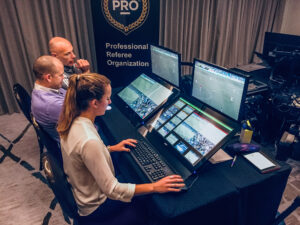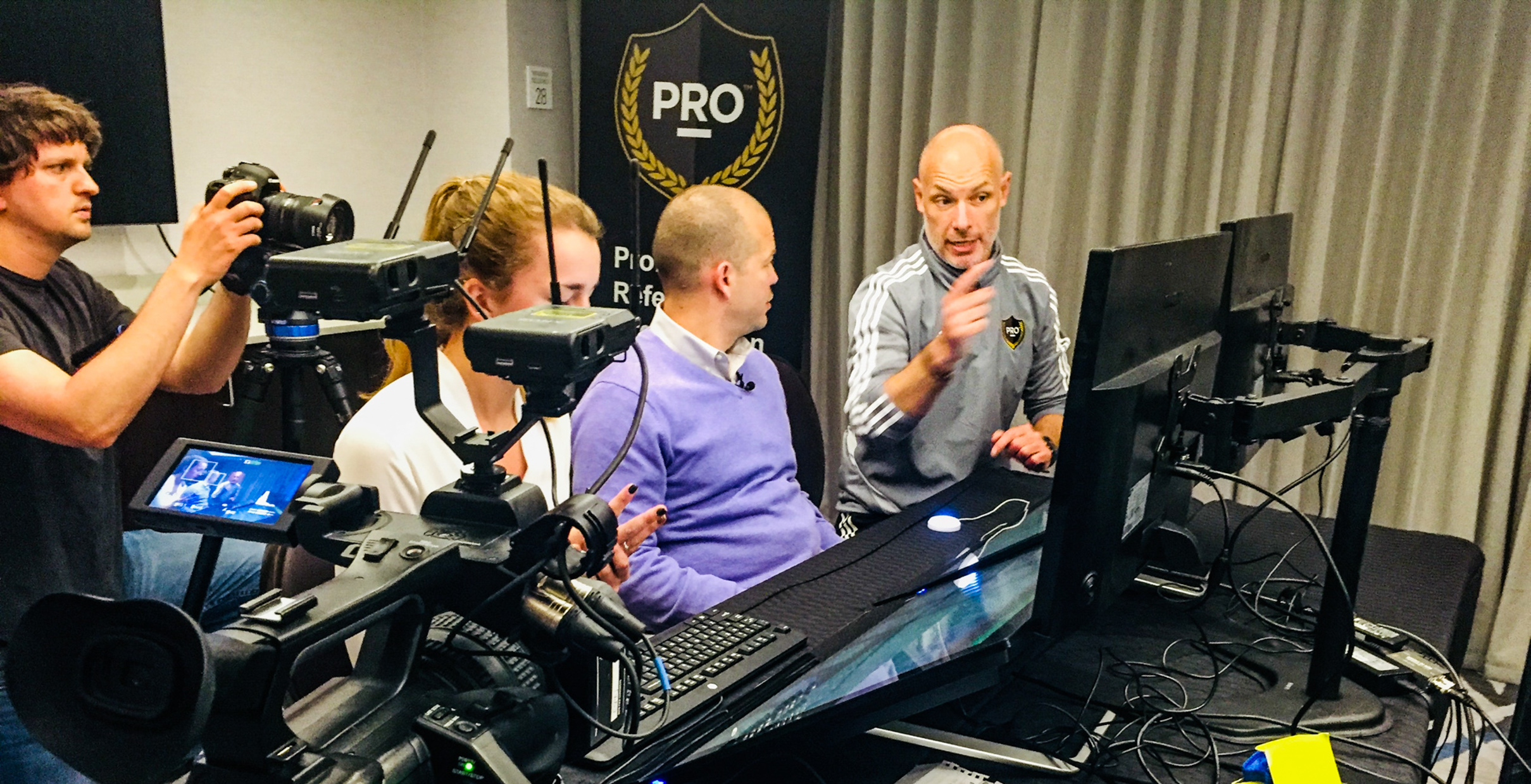Charlie sees some progress in EPL’s implementation of VAR but convincing the UK footballing landscape, though, is a stretch more difficult than MLS.
I’m not a former referee, nor do I claim to be an officiating or Video Assistant Referee (VAR) expert. But one thing I can claim is that I had the privilege of working alongside one of the top referees and footballing intellectual minds: Howard Webb, the PGMOL (Professional Game Match Officials Limited) chief operating officer, who has now completed his first season overseeing the Premier League officials.
Howard Webb (back) showing the VAR process alongside ESPN FC’s Alejandro Moreno in 2019
When Webb was general manager at the Professional Referee Organization (PRO) in the USA, I was working in Major League Soccer’s communications department in New York City. MLS was one of the first leagues to fully integrate VAR in professional matches during the latter third of the 2017 season. The EPL did not implement it until the 2019-20 season.
One of my tasks in 2019 was coordinating communications efforts on officiating and VAR matters, especially with broadcast partners and talent. When a ruling or even official statement was needed to clarify certain calls or provide background on how decisions were made, I was a go-between from PRO (Webb) to the broadcast booth and club PR.
It was an intriguing behind-the-scenes task, going over all the nuances involved in the process, which required both accuracy and promptness.
I watch the game in a different light these days, having gone through hundreds of matches with VAR and officiating rulings constantly in my mind.
As unbridled Brentford FC fans, I don’t expect to sway folks on calls that haven’t gone in the club’s direction, and most supporters naturally have a disdain for officiating in general. I can, however, pinpoint some noticeable trends, especially having seen the initial products of VAR at both MLS and from afar in the EPL
Defining ‘Clear and Obvious’ Threshold:
I’m not going to paint all roses over the VAR setup. There are some controversially disappointing elements, and I am especially not a fan of the usage of Hawk-Eye virtual offside in the EPL. It requires manual determination to specify the point of contact of the pass and the attacking player’s position and reception of the ball in question. Sometimes it boils down to a shoulder-sleeve offside. I come from the MLS school of VAR where you go with the call on the pitch, and if it’s a “clear and obvious” offside or onside discrepancy, then you intervene.
EPL VAR Lee Mason was dismissed after not drawing the virtual offside line during Brentford’s equalizer against Arsenal in February. The call on the pitch was an Ivan Toney goal, and it stood that way, with no line drawn to determine if Christian Norgaard was offside in the buildup. The VAR was booted for not going to the Hawk-Eye technology in what was a close call to the natural eyes.
The funny part about this to me is that if it were the MLS VAR implementation, it would have been a goal call, a “check complete” from the VAR, and we all would have quickly moved on with our lives. (Maybe not Mikel Arteta.)
The Hawk-Eye offside technology was in place before Webb’s arrival, and I’d love a reporter to ask him what his thoughts are on it, because the MLS setup (with fewer camera angles and a smaller budget) was kind of a blessing in disguise. EPL offside technology is too much “re-refereeing.”
Proactivity, Heading to the Monitor:
This precedes Brentford’s promotion by a couple years, but for context, the start of VAR in this league was even more of a mess in 2019. The referee showed little to no interest in going to the monitor. Sometimes they simply let their own calls stand, despite a recommendation, and other times they would take the VAR’s recommendation ruling and not go to the monitor to verify. The league didn’t enforce or fully communicate this process.

Howard Webb (back) showing the VAR process alongside ESPN FC’s Alejandro Moreno in 2019.
Meanwhile, here in the USA and Canada, Webb’s work at MLS was garnering positive reviews in the two-plus years of VAR. Proactive verification protocol was in place to fully utilize the VAR’s recommendations, and referees were encouraged to use the pitchside monitor (sometimes too often in the early days; PRO felt it served as a public confirmation tool for viewers).
The MLS VARs were also earning high-profile international appointments on a regular basis, such as American Mark Geiger (2017 FIFA Club World Cup VAR) and Canadian Drew Fischer (VAR in the 2019 FIFA Women’s World Cup).
Fast forward to today, and the EPL process is starting to show signs of a more proactive usage between the referee and VAR. The integration of the tools and pitchside monitors are more common, and that early hesitation from several years earlier has faded.
Communication Strides:
In Mid-May, Webb and the PGMOL released mic’d up communication of various behind-the-scenes decisions for the first time. This is the most significant VAR-related stride I have seen from a public standpoint. It’s an unprecedented move, really, and a big step in the right direction. It needs to be a frequent, week-by-week segment.
The downside is that it will never happen in real time, the way fans want this. PGMOL most certainly goes through a rigorous review process of the performances of its referees, VARs and AVARs (Assistant Video Assistant Referees), and only until the completion of these reviews would they then formulate the approval for such video segments for public consumption.
Nevertheless, it’s a helpful tool. VAR rulings are still a secondary language to even the most fanatic football folks, and more transparency is vital.
Accountability:
Webb had a stretch where PGMOL and the Premier League formulated official statements admitting errors in judgment, with Brighton certainly one of the more noteworthy clubs to wind up in the crosshairs. There also was that Brentford-Arsenal situation I mentioned earlier. Heads of officials rarely showcase that much accountability on a public scale.
It’s a double-edged sword, though. I applaud the direct recognition, but the negative end is it means the quality of the officiating/VAR dynamic needs improvement.
That brings us to the public sentiment, and the pundits, media outlets and supporters are out there in full force with mostly negative reviews of the VAR process. I get it. The system will never be perfect, especially because there are so many moving parts. This isn’t stationary Hawk-Eye technology to determine whether a tennis serve is in or out.

Howard Webb with Seattle Sounders FC supporters at halftime of the 2019 MLS Cup in Seattle.
I have an abundance of bias in saying that I think under Webb, there will be continual improvement in this controversial space.
We have to remember what the core of this process should be: To utilize VAR as a supplemental tool, to intercede on the most crucial moments, so there is no Diego Maradona “Hand of God”-like incident.
While we should explore technological uses to the fullest extent, there are moments of intervention when we should scale back and recognize whether an “obvious” error has taken shape. The EPL is still finding that balance, and we’re trying to reform decades’ worth of thinking.
Sometimes less is more, but we won’t be going backwards on this project. VAR is here to stay.
Photos – Charlie Coor
Charlie Coor – NYC Bees

